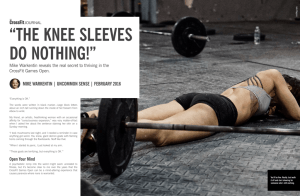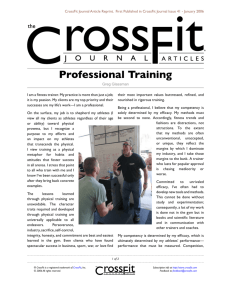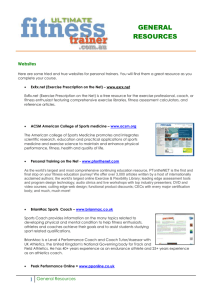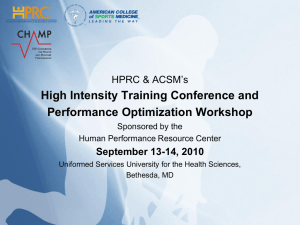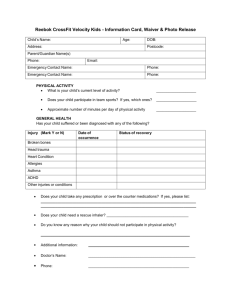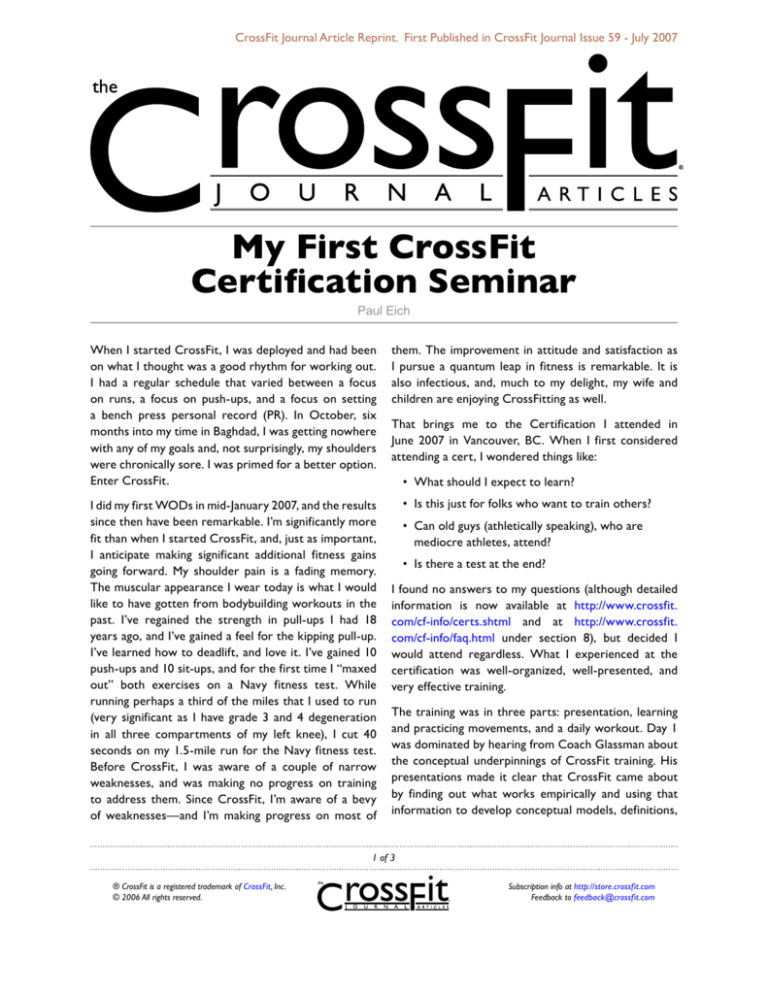
CrossFit Journal Article Reprint. First Published in CrossFit Journal Issue 59 - July 2007
My First CrossFit
Certification Seminar
Paul Eich
When I started CrossFit, I was deployed and had been
on what I thought was a good rhythm for working out.
I had a regular schedule that varied between a focus
on runs, a focus on push-ups, and a focus on setting
a bench press personal record (PR). In October, six
months into my time in Baghdad, I was getting nowhere
with any of my goals and, not surprisingly, my shoulders
were chronically sore. I was primed for a better option.
Enter CrossFit.
I did my first WODs in mid-January 2007, and the results
since then have been remarkable. I’m significantly more
fit than when I started CrossFit, and, just as important,
I anticipate making significant additional fitness gains
going forward. My shoulder pain is a fading memory.
The muscular appearance I wear today is what I would
like to have gotten from bodybuilding workouts in the
past. I’ve regained the strength in pull-ups I had 18
years ago, and I’ve gained a feel for the kipping pull-up.
I’ve learned how to deadlift, and love it. I’ve gained 10
push-ups and 10 sit-ups, and for the first time I “maxed
out” both exercises on a Navy fitness test. While
running perhaps a third of the miles that I used to run
(very significant as I have grade 3 and 4 degeneration
in all three compartments of my left knee), I cut 40
seconds on my 1.5-mile run for the Navy fitness test.
Before CrossFit, I was aware of a couple of narrow
weaknesses, and was making no progress on training
to address them. Since CrossFit, I’m aware of a bevy
of weaknesses—and I’m making progress on most of
them. The improvement in attitude and satisfaction as
I pursue a quantum leap in fitness is remarkable. It is
also infectious, and, much to my delight, my wife and
children are enjoying CrossFitting as well.
That brings me to the Certification I attended in
June 2007 in Vancouver, BC. When I first considered
attending a cert, I wondered things like:
• What should I expect to learn?
• Is this just for folks who want to train others?
• Can old guys (athletically speaking), who are
mediocre athletes, attend?
• Is there a test at the end?
I found no answers to my questions (although detailed
information is now available at http://www.crossfit.
com/cf-info/certs.shtml and at http://www.crossfit.
com/cf-info/faq.html under section 8), but decided I
would attend regardless. What I experienced at the
certification was well-organized, well-presented, and
very effective training.
The training was in three parts: presentation, learning
and practicing movements, and a daily workout. Day 1
was dominated by hearing from Coach Glassman about
the conceptual underpinnings of CrossFit training. His
presentations made it clear that CrossFit came about
by finding out what works empirically and using that
information to develop conceptual models, definitions,
of 3
® CrossFit is a registered trademark of CrossFit, Inc.
© 2006 All rights reserved.
Subscription info at http://store.crossfit.com
Feedback to feedback@crossfit.com
My First CrossFit Certification Seminar (continued...)
and methodology that encompass those findings.
However, given CrossFit’s open-source, performancebased approach, the concepts are also significant from
the perspective that advancing a field of knowledge
requires a theory (I attribute my understanding of this
idea to Peter Senge’s The Fifth Discipline). A theory
can be tested, evaluated, and then become the basis
of further learning (whereas untested and untestable
theories abound in the fitness/martial arts worlds and
are not generally useful). With a testable theory to
explain CrossFit’s results, a practitioner can go beyond
“monkey see, monkey do” and better evaluate the
observed results.
Should you go to a certification? My answer is, if you want
to learn to move your body better—much better—and
especially if you are not located near a CrossFit affiliate,
yes! You should also go if you want to be able to train
others to do CrossFit. You should go to a certification
if you want to be around a bunch of people who are as
comfortable with pain as you are. And you should go to
a certification to meet the really interesting people who
have given birth to CrossFit.
The people who run the certifications are a remarkable
group. Many of them are some of the powerful athletes
on display for us in the videos, demos, and photos
on CrossFit.com. But Coach Glassman has obviously
selected his team with great care, and for more than
their athletic prowess, because the group was just as
remarkable for their sincerity and professional approach
to training. The staff was very gracious while also being
confident, competent, and demanding (without being
demeaning). It’s a powerful combination.
Aside from the staff, I met many people during the cert
(I knew not a soul when I arrived on Friday night), and
they were all good company. It seemed there was an
almost even number of guys and gals, and most were
aged 25 to 40, but there were a few even more seasoned
than I was. I’d go back next weekend to do a WOD
and hang out with them if I could; it was a weekend
memorable for meeting a bevy of really grand people.
As fellow CrossFitter Barry Cooper said to me when
I was preparing for the cert: “Sure, it won’t hurt to be
in great shape for the cert, but it is guaranteed some
110-pound female is going to crush you. Because of that,
CrossFitters are characteristically humble.” Well, Barry,
some did, and they were!
So you must be thinking, “Enough of the pleasantries,
did the cert make a difference in your training?” Yes,
it did, in many ways. First, even though I’ve been lifting
weights and squatting since 1980, and even though I
had worked up to doing 400 air squats in 15 minutes
before I started CrossFitting, I found out how little I
knew about that fundamental body movement. I found
out that even after reading Mark Rippetoe’s articles
carefully four times on my own, I was still missing big
experiential chunks of how to tell what a deadlift should
feel like. I can complete a front squat now, correctly, and
without pain in my forearms/wrists. I found out how to
do a dumbbell thruster correctly (so much easier than
I was making it!). I can “feel it’ when I do the Burgener
Warm-Up correctly. I am no longer intimidated by squat
cleans and have some clue about how to do them right.
(The clean is a movement I detested but now am eager
to learn, which brings to mind Coach’s quote from the
cert: “It’s amazing how useless an activity can seem to
be when you suck at it.” It also leaves me eager to attend
one of CrossFit’s Olympic lifting certification seminars.)
When people ask, I can say, “CrossFit is constantly
varied, functional movements, performed under load
at relatively high intensity and over relatively long
distances”. Most importantly, I can better feel when I’m
using my body—especially my hips, my spine, and their
coordination—correctly.
This has opened up a world of opportunity for learning
and highlights how fundamentally applicable CrossFit is.
Athletes of all ages, sizes, athletic abilities, and fitness
levels need to master essentially the same movements.
Knowing how to deadlift, one can efficiently lift objects
from the ground the rest of one’s days. Developing a
fundamentally sound squat is a gateway to a lifetime of
mobility. I predict that if you don’t see it already, a cert
(or perhaps the equivalent 16 hours of personal training
with an expert CrossFit trainer) will give you an intuitive
understanding of what functional movement means, and
that understanding will help you sort out the exercise
wheat from the exercise chaff.
The only downside of attending the cert is that I now
know how poorly I had been coaching my training
of 3
® CrossFit is a registered trademark of CrossFit, Inc.
© 2006 All rights reserved.
Subscription info at http://store.crossfit.com
Feedback to feedback@crossfit.com
My First CrossFit Certification Seminar (continued...)
partner from Baghdad, the stalwart Captain David
Pollock. Sorry Dave. I am glad you thrived in spite of my
shortcomings.
I believe my new understanding of better movement
will drive better performance, but I won’t know until
my next bouts with the benchmark “girls”; they are
my measuring stick. The only one I’ve tried since the
certification delivered a marginally positive result,
with a nine-second improvement on “Fran.” What is
significant, though, is that I was able to complete much
improved—legitimate—pull-ups, which meet what I
now realize is the CrossFit standard.
So, that’s (some of) what you can expect to learn. As
for the answers to the other questions I had: “No, it’s
not just for those who want to train others.” “Yes, old
and/or mediocre athletes can attend.” “No, there’s
no (written) test.” So, yes, go to a certification, enjoy
the CrossFit community through a greater depth of
engagement, and learn to use your body better. As with
the WOD, what are you waiting for? 1, 2, 3, GO!
Paul Eich, a.k.a. “Apolloswabbie,” is relatively new
to CrossFit but brought with him the baggage
of over 30 years of uncoached weightlifting,
cycling, and running. He was awarded instructor
rank in Shotokan karate in 1997. A Naval
Aviator with 18 years on active duty, his three
most recent deployments were to the Central
Command Area of Responsibility and included a
tour launching combat missions from the deck
of the USS Enterprise, flying combat missions
in support of Operation Enduring Freedom,
and serving with the U.S. Army on the MultiNational Corps - Iraq.
of 3
® CrossFit is a registered trademark of CrossFit, Inc.
© 2006 All rights reserved.
Subscription info at http://store.crossfit.com
Feedback to feedback@crossfit.com

